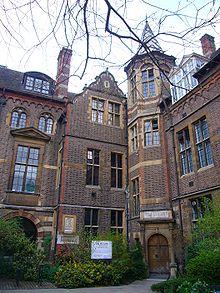- Museum of Archaeology and Anthropology, University of Cambridge
-
This article is about an archaeological museum in the United Kingdom. For the museum in Massachusetts, see Peabody Museum of Archaeology and Ethnology.
The MAA : Museum of Archaeology and Anthropology at the University of Cambridge houses the University's collections of local antiquities, together with archaeological and ethnographic artefacts from around the world. The museum is located on the University's Downing Site, on the corner of Downing Street and Tennis Court Road.
History
Founded in 1884 as the University's Museum of General and Local Archaeology, the museum initial collections included local antiquities collected by the Cambridge Antiquarian Society and artefacts from Polynesia donated by Alfred Maudslay and Sir Arthur Gordon. Anatole von Hügel, the Museum's first Curator donated his own collection of artefacts from the South Pacific. A collection of Western Australian aboriginal material was acquired from Emile Clement. More material was collected by the 1898 Cambridge anthropological expedition to the Torres Strait under Alfred Haddon and W. H. R. Rivers. Haddon and Rivers would encourage their Cambridge students — including Alfred Radcliffe-Brown, John Layard and Gregory Bateson — to continue to collect for the museum in their ethnographic fieldwork.
Von Hügel set in motion a move to larger, specially built, premises: in 1913 the museum moved to its present location in Downing Street, although the new galleries were not fully installed until after World War I. Various depositions and donations of eighteenth-century collections — including material collected on James Cook's three expeditions — were made to the museum in the 1910s and 1920s.
Von Hügel's successors as curator have been Louis Colville Gray Clarke (from 1922 to 1937), Thomas Paterson (from 1937 to 1948), Geoffrey Bushnell (from 1948 to 1970), Peter Gathercole, Prof. David Phillipson, and the present Director, Prof. Nicholas Thomas. Its displays are arranged on three floors:
- Ground floor: The Clarke Gallery (World Archaeology)
- First floor: The Maudslay Gallery (World Anthropology)
- Second floor: The Andrews Gallery (Changing Exhibitions)
External links
Further reading
- V. Ebin and D.A. Swallow, “The Proper Study of Mankind…”: great anthropological collections in Cambridge. University of Cambridge Museum of Archaeology and Anthropology, 1984
- A. Herle and J. Philp, Torres Strait Islanders: an exhibition marking the centenary of the 1898 Cambridge Anthropological Expedition to the Torres Strait. University of Cambridge Museum of Archaeology and Anthropology, 1998.
- J. Tanner, From Pacific Shores: eighteenth-century ethnographic collections at Cambridge. University of Cambridge Museum of Archaeology and Anthropology, 1999.
- Robin Boast, S. Guha and A. Herle Collecting Sights: the Photographic Collections of the Museum of Archaeology & Anthropology, 1850—1970. Cambridge: Museum of Archaeology and Anthropology, Cambridge University Press, 2001
- Haidy Geismar and Anita Herle: Moving images.John Layard, fieldwork and photography on Malakula since 1914, with contributions by Kirk Huffman and John Layard; Crawford House Publishing Australia, Adelaide in association with University of Cambridge Museum of Archaeology & Anthropology, Cambridge 2009 ISBN 978-1-86222-3-191
Coordinates: 52°12′09.7″N 0°7′15.6″E / 52.202694°N 0.121°E
Categories:- Museums established in 1884
- Museums of the University of Cambridge
- Archaeology museums in England
- Anthropology museums
Wikimedia Foundation. 2010.

